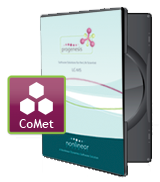Fundamental concepts in the CoMet workflow
The workflow in Progenesis CoMet is designed to provide accurate measurement of the compounds in your samples in a way that allows robust statistical analysis and comparison across runs; the process is outlined here.
Importing your data
After being imported, each run in your experiment is represented as an ion intensity map (show me), or ion map for brevity, mapping the sample's MS signal by m/z and retention time. This gives an immediate visual quality check, highlighting any problems experienced in sample running.
Alignment and quantification
These ion maps are then aligned in the retention time direction. From the aligned runs, CoMet produces an aggregate run that is representative of the compounds in all samples, and uses this aggregate run for peak picking.
The result of peak picking is a set of features, each feature representing a single compound ion and any associated isotopes (show me). Depending upon your chosen ionisation technique, these compound ions may be the original compound with an attached adduct, or simply different charge states of the original compound. Regardless, the same feature pattern is quantified on all runs, allowing robust statistical analysis with no missing values.
Finding interesting behaviour
At this point, the focus turns to finding the compounds whose abundance shows interesting differences across the experimental conditions (e.g. treatment vs. control). For this, we define the experiment structure, which CoMet uses to calculate variance, fold change and other measurements for our features.
Identifying the features
At this stage, CoMet has quantified the features, but they have yet to be identified. After using the features' measurements to find the compound ions with the most interesting behaviour, these can be identified using an external metabolite database or search engine.
The identification results are then imported and automatically assigned to the relevant features. Depending upon the metabolite database used, your features may have been assigned more than one possible identification (show me). Conversely, more than one feature may have been assigned the same compound identification, but with different adducts or charge states.
Collating features by compound
The final step in CoMet's analysis is to group the features by their shared identifications, giving overall compound abundances, rather than merely abundances of individual adducts or charge states. For each of these compounds, the identification deemed most likely to be correct can then be marked and all associated measurements and other data exported.





